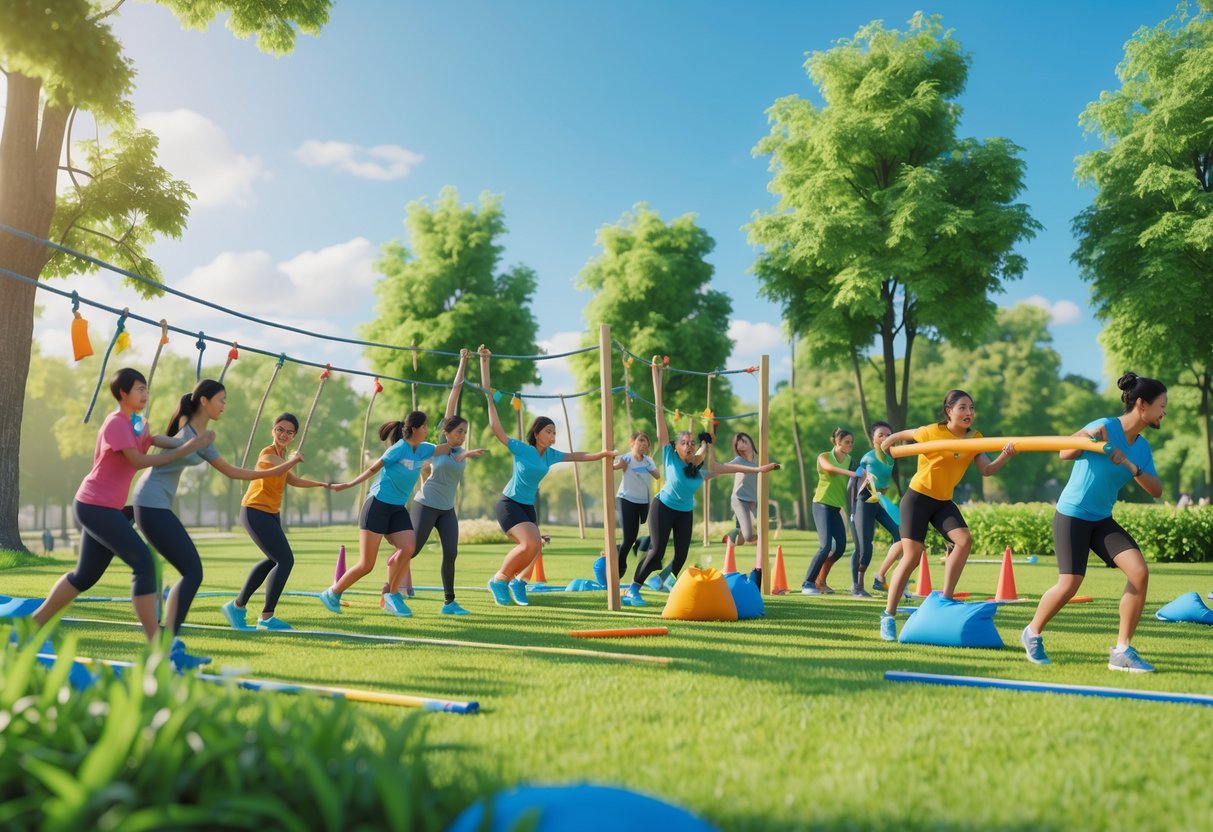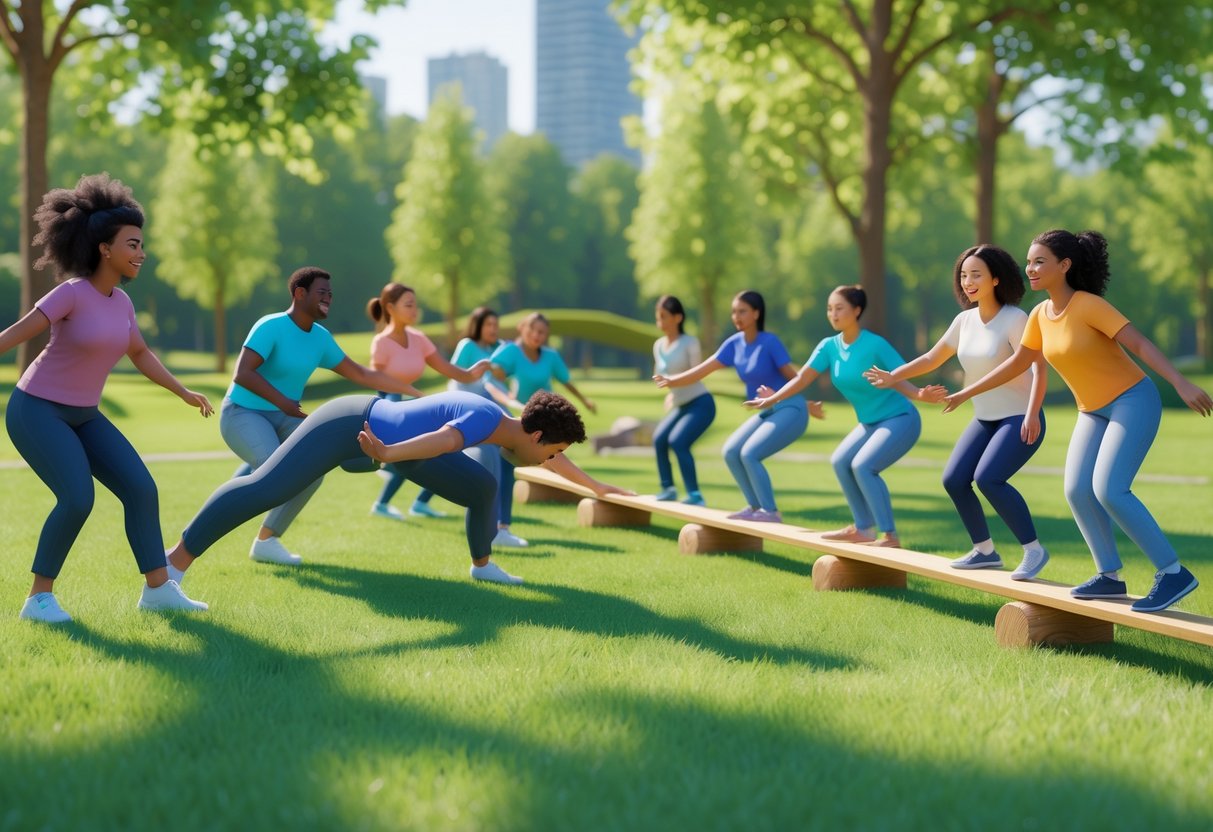Team Building Activities: Comprehensive Guide for Dynamic Teams
Updated On: October 26, 2025 by Aaron Connolly
Key Benefits of Team Building Activities
Team building activities actually help groups work together better. These exercises spark stronger communication, encourage creative problem-solving, and help people form real professional relationships that make work smoother.
Improving Collaboration
Team building changes how colleagues approach shared projects. When we take on group challenges, we start to notice how everyone works and what they do best.
These activities break down department walls. Staff from different teams finally see how their roles fit together.
This understanding really helps cross-team projects run smoother.
Trust grows during team exercises. Team members start to rely on each other to get things done, and that trust sticks around in daily work.
Problem-solving tasks show us how different skills click together. Maybe one person plans well and another thinks up creative fixes.
Team building helps us spot these skills and use them.
Regular collaborative exercises cut down on conflicts. We start to appreciate different points of view.
This creates a more supportive vibe for everyone.
Boosting Communication Skills
Team building activities give us a safe place to practise talking and listening. We get better at sharing ideas and really hearing what others say.
A lot of these exercises involve giving and getting feedback. That makes tough conversations at work feel less scary.
Clear communication turns into a habit instead of something we dread.
Face-to-face activities help us read body language and tone. These skills come in handy during meetings and help avoid confusion.
Virtual team building lets remote workers figure out how to communicate online. We learn which platforms fit different types of chats.
That knowledge makes digital teamwork easier.
Partner exercises help us practise active listening. We focus on what others are saying, which means fewer mistakes and stronger work relationships.
Fostering Creativity
Team building pushes us to think differently. New settings and weird challenges get our brains firing with fresh ideas.
Brainstorming gets a boost after creative team activities. We feel less weird about sharing off-the-wall suggestions.
That’s how teams find new solutions nobody expected.
Mixed-group activities bring different perspectives together. Marketing folks solving puzzles with IT? You’d be surprised what ideas pop up.
Creative challenges make us braver about taking risks. We learn that even failed attempts can lead to better answers.
That makes us less afraid to pitch bold ideas at work.
Role-playing exercises help us see things from other viewpoints. When we understand customers or coworkers better, service and teamwork improve.
Those new perspectives can really drive innovation.
Enhancing Team Bonding
Team building helps us connect on a personal level. We find out who shares our interests or has similar experiences.
These bonds make working together feel easy, not forced.
Trust exercises boost our confidence in the team. Knowing someone’s got your back lowers stress and anxiety.
That kind of emotional support makes work feel better.
Shared wins during activities create good memories. When we finish a challenge together, we feel proud as a group.
Teams celebrate victories more after they’ve bonded.
Social connections lift morale. It’s just more fun to work with people you actually like.
That energy spreads and helps everyone get more done.
Team activities shine a light on everyone’s strengths. When we celebrate each other, respect grows.
That kind of appreciation sticks around long after the activity ends.
Popular Icebreakers for Teams

These four team-building activities suit groups of any size and don’t take much prep. They help teammates learn about each other while building trust and communication skills that carry into real work.
Two Truths and a Lie
Each person shares three things about themselves—two true, one false. The group tries to guess which one’s the lie.
This classic icebreaker works because it uncovers surprising facts and gets people thinking creatively. Folks often share wild travel stories, hidden skills, or quirky hobbies.
How to play:
- Give everyone a couple of minutes to come up with their statements
- Go around the room sharing
- Let people discuss before revealing the lie
- Keep it moving so nobody gets bored
It usually takes 10-15 minutes for a small group. Mixing personal and work-related facts keeps it friendly and professional.
Quick tip: Ask people to make their lie believable and their truths a bit unexpected. That keeps things interesting.
Would You Rather
Give the group tough choices between two options. Everyone picks one and explains why.
This icebreaker shows off personality, values, and how people make decisions. The real magic is in the conversations that follow.
Sample questions for teams:
- Would you rather work from home forever or never work remotely again?
- Would you rather fly or read minds?
- Would you rather lose your smartphone or your laptop for a month?
- Would you rather always be 10 minutes late or 20 minutes early?
Pick questions that get people talking. Skip anything too personal for work.
Pro tip: Ask follow-up questions to keep the chat going and encourage quieter folks to join in.
Human Bingo
Make bingo cards with different traits, skills, or experiences in each square. Everyone wanders around, finding colleagues who match each description and collecting signatures.
This gets people up and mingling, even with teammates they don’t know well. It’s great for big groups or welcoming new hires.
Sample bingo squares:
- Has visited more than 5 countries
- Speaks another language
- Has run a marathon
- Owns a pet
- Plays an instrument
- Worked in customer service
Use 16-25 squares for a regular game. Mix work skills and personal stuff for more fun.
Warning: Don’t use topics that are too specific or sensitive. You want everyone to feel included.
Show and Tell
Team members bring something meaningful—an object or photo—and tell the group its story.
This format works because people choose what to share, and the objects spark genuine conversations. Often, someone’s item leads to new questions and connections.
Good show and tell ideas:
- Childhood items: Photos or objects from growing up
- Travel souvenirs: Stuff from memorable trips
- Hobby pieces: Tools or creations from personal interests
- Achievement symbols: Awards, certificates, milestone markers
Give everyone a couple of minutes to share. For virtual teams, folks can show things on camera or share a photo.
Quick win: Ask at least one follow-up question for each person. It shows you’re listening and helps the group go a bit deeper.
Quick Team Building Activities for Busy Schedules
These activities only take 5-15 minutes and work great when you’re short on time but want to boost team energy. They’re perfect for kicking off meetings, shaking off afternoon slumps, or connecting remote teams quickly.
Speed Networking
Speed networking turns your team into a mini conference. Each person gets two minutes to chat with a colleague before switching.
Set up pairs around the office or use breakout rooms online. Ring a bell every two minutes, and everyone rotates.
Offer conversation starters like “What’s your favorite project this month?” or “What’s one skill you want to learn?” That keeps things moving.
Why it’s awesome:
- People meet colleagues they don’t usually talk to
- Shy folks get equal speaking time
- You’ll probably learn something unexpected
Remote teams can use video calls with breakout rooms that shuffle automatically. Most platforms make this easy.
Speed networking creates a bunch of new connections in less than 15 minutes. People often find out they have things in common they never noticed before.
Common Ground
Common Ground helps teams find shared interests outside of work. Split everyone into groups of four or five.
Each group gets five minutes to list as many things they all have in common as possible. The catch? No work topics allowed.
Groups might discover a shared love of true crime podcasts, pets, or reality TV. The weirdest connections usually get the biggest laughs.
Sample categories:
- Hobbies and interests
- Travel stories
- Favorite foods
- Childhood memories
Give bonus points for the most unique shared experiences. If everyone learned piano as a kid, that’s worth more than “we all drink coffee.”
This activity works for hybrid teams too. Remote folks can join by video while office groups gather in person.
The fun part is when people realize they share more than they thought. These conversations often keep going after the activity ends.
Emoji Storytelling
Emoji storytelling turns everyone into creative writers using only emojis. Each person gets five random emojis and has to make up a short story that uses all of them.
You can use online emoji generators or have people scroll through their phones with their eyes closed to pick randomly. The randomness makes stories funnier.
Give everyone three minutes to write, then share stories with the group. You’ll be surprised at the wild plots people invent.
Fun emoji combos:
- 🚂🎭🌙🍕🦋 (train, theatre mask, moon, pizza, butterfly)
- 🏰🐙🎸🌮⚡ (castle, octopus, guitar, taco, lightning)
- 🚁🦙🍰🌊🎯 (helicopter, llama, cake, wave, target)
For remote teams, people can type their emojis in the chat and share stories on video. It works really well for virtual meetings.
This activity uncovers hidden storytellers and gets everyone laughing. Some teams like it so much they keep the emoji stories going all week.
Back-to-Back Drawing
Back-to-back drawing puts communication skills to the test and usually gets everyone giggling. Pair up team members and have them sit with their backs touching.
Give one person a simple drawing—maybe a house, or a cat in a hat. They describe the image, and their partner tries to draw it without seeing the original.
The describer can’t say what the object is. So, instead of “draw a cat,” they’d say, “draw a furry creature with pointy ears and whiskers.”
What you’ll need:
- Simple line drawings or shapes
- Paper and pens for each pair
- Timer set for five minutes
When time’s up, compare the original and the copy. The results are usually hilarious and sometimes shockingly close.
For virtual teams, use two devices or cover cameras so the drawer can’t peek. The describer shares their image privately and explains it out loud.
This exercise shows how differently people interpret instructions. Teams learn to ask clarifying questions and get specific.
Indoor Team Building Activities
When outdoor plans get rained out, indoor team building games offer creative ways to build bonds and boost teamwork. These activities work well in offices, meeting rooms, or rented spaces, no matter the weather.
Pictionary
Pictionary can turn any meeting room into a place for laughs and creative problem-solving. We split into groups of 4-6, one person draws, and the others guess the word or phrase.
Why teams love it:
- Communication skills grow as drawers learn to show ideas visually
- Creative thinking pops up when drawing the obvious doesn’t work
- Time pressure adds a little excitement, just like real work deadlines
What you need:
- Flipchart paper or a whiteboard
- Markers or pens
- Cards with business terms, company values, or just fun words
- Timer (2-3 minutes per round)
Teams usually play for an hour or so, with drawers rotating. Mixing up departments helps break down barriers between different parts of the business.
The best part? Watching how everyone solves problems in their own way. Some people draw exactly what they see, others go for symbols or abstract ideas.
Lip Sync Battle
Lip sync battles really let people show off their personality and confidence without the stress of singing live. Teams pick songs and perform, putting all the focus on energy and fun.
Why it builds teams:
- Breaks down barriers for both shy and outgoing folks
- Encourages risk-taking in a space where nobody’s judging
- Creates shared memories that can actually make work relationships stronger
Essential elements:
- Decent speakers for music
- Open space for performances—a cleared-out meeting room works
- Easy props like scarves, sunglasses, or inflatable guitars
- Judging based on creativity, not singing ability
Groups of 3-5 seem to work best. That way, everyone can join in without feeling overwhelmed.
Plan for about 90-120 minutes, counting time to pick songs.
The main thing? Keep it fun, not perfect. When managers jump in and go for it, people notice that taking risks is okay here.
Skribbl.io
Skribbl.io takes the old-school drawing game online, and it’s perfect for hybrid teams or anyone who just loves tech. Players draw prompts while the rest try to guess through chat in real-time.
Digital advantages:
- Remote inclusion so everyone can play, no matter where they are
- Built-in scoring keeps things fair
- Custom word lists let you slip in company lingo
Technical setup:
- Everyone needs a good internet connection
- Tablets or computers that can handle drawing
- Video call running so you can laugh and react together
Sessions run well for 45-60 minutes, with 6-10 players in a room. If you’ve got more people, just split into multiple games.
Team building benefits:
- Digital collaboration skills just happen naturally
- Patience grows when you’re waiting for someone to finish their masterpiece
- Inclusive participation since drawing skill isn’t the main thing—creativity matters more
The online setup sometimes uncovers tech skills you didn’t know your teammates had. That’s pretty useful in today’s workplace.
Outdoor and Physical Team Challenges

These activities mix fitness with teamwork to help people build trust and communicate better. Teams have to work together to overcome physical obstacles, compete in races, and think strategically during games.
Obstacle Course
Obstacle courses throw teams into physical challenges that demand support and encouragement. We set up courses with natural terrain or portable gear like ropes, tyres, and climbing walls.
Teams of 4-6 move through the course together. Each person needs help from teammates for advice, motivation, or even a boost over a wall.
Common obstacles? Rope climbs, balance beams, scaling walls, crawling sections.
Essential equipment needed:
- Harnesses and helmets for safety
- Rope sections (10-15 metres)
- Cones to mark boundaries
- First aid kit and someone trained to supervise
The course usually takes 2-3 hours. We always have backup challenges ready for different fitness levels.
Some obstacles trip people up, so alternative routes keep everyone in the game.
Teams that talk things out and cheer each other on tend to do better. Celebrating small wins goes a long way.
Relay Races
Relay races always get the energy up and spark some friendly rivalry. We set up stations where each team member does a different task before handing off to the next.
Popular relays? Sack races, three-legged runs, egg-and-spoon, and even puzzle stations. Each one tests something different—speed, coordination, or problem-solving.
Teams of 6-8 work best. If you have more, split into smaller groups for a tournament vibe.
We design races so everyone gets a turn, no matter their athletic ability.
Typical relay station ideas:
- Physical tasks (hopping, carrying stuff)
- Mental puzzles (riddles, word games)
- Creative activities (drawing, building)
- Skill-based games (throwing, balancing)
Mixing up the challenges keeps things fair and lets everyone shine at something.
Capture the Flag
Capture the Flag pushes teams to think strategically and work together. Two teams guard their own territory while trying to grab the other team’s flag and bring it home.
We lay out a big playing field with clear boundaries and safe zones. Each team gets 15-20 minutes to plan before the game starts.
Teams have to balance attacking with defending their own flag.
If you get tagged in enemy territory, you freeze until a teammate rescues you. That rule creates all kinds of teamwork moments and quick decisions.
Game setup requirements:
- Big outdoor space (think football field)
- Two flags or markers
- Colored bands for teams
- Whistle for the ref
Games usually run 30-45 minutes, and we play multiple rounds. We also rotate players between offense and defense so everyone gets a shot at both.
Creative Problem-Solving Activities
These activities challenge teams to think fast and find creative solutions under a little pressure. Each one needs different skills, but they all get people working together and solving problems hands-on.
Egg Drop Challenge
The egg drop challenge makes teams think on their feet and decide fast. We give out simple materials—newspaper, tape, straws, balloons—and teams have to build something to protect an egg.
The goal? Keep the egg from breaking when dropped from up high.
Usually, we give teams 15 minutes to build before the testing starts.
Materials needed:
- Raw eggs (one per team)
- Newspaper or magazines
- Masking tape
- Drinking straws
- Balloons or bubble wrap
- Rubber bands
Teams have to juggle weight, cushioning, and structure all at once. It’s a bit chaotic.
Start with a shoulder-height drop. If a bunch of eggs survive, go higher. The suspense is real.
Teams have to talk quickly and split up jobs. Some design, some build.
Marshmallow Challenge
Honestly, the marshmallow challenge is a favorite. Teams try to build the tallest tower using spaghetti, tape, string, and a marshmallow.
Set a timer for 18 minutes. The tower has to stand on its own and hold the marshmallow on top.
What you’ll need:
- 20 sticks of uncooked spaghetti per team
- One roll of masking tape
- One metre of string
- One marshmallow
- Measuring tape
Teams learn quickly that planning is good, but building and testing matter more.
The marshmallow is heavier than you’d think, and it often brings towers crashing down at the last second.
Teams that build and adapt as they go usually win. Quick prototypes beat endless debate every time.
Bridge Build
Bridge build challenges teams to make a structure that holds weight with just a handful of supplies. We usually use index cards, tape, and paper clips.
Teams have to bridge a 30cm gap between two tables. The bridge should hold as much weight as possible before collapsing.
Standard materials:
- 50 index cards per team
- One roll of tape
- 25 paper clips
- Small weights (coins work well)
It’s a mix of physics and teamwork. Someone holds pieces, someone tapes, and everyone has to agree on a design—fast.
Most teams try either arches or suspension bridges. Both can work if you build them right.
Add weight slowly—one coin at a time—so the suspense builds. The team with the strongest bridge usually gets bragging rights.
Some focus on brute strength, others try to use as few materials as possible. Both approaches can work, depending on the rules.
Collaboration and Communication Games

These games help teams build trust by tackling shared challenges together. Each activity pushes people to work as a unit while practicing communication skills that actually matter at work.
Human Knot
The human knot is a classic for getting people to talk and listen. It’s a physical puzzle that can get silly fast.
How it works: 6-8 people stand in a circle, then reach across to grab hands with two different people. The goal? Untangle yourselves without letting go.
What makes it effective: Teams have to talk through every step and actually listen. Sometimes, the quietest person spots the answer.
Time needed: 10-15 minutes per round.
This game teaches patience and shows why it’s important to speak up when you see a solution.
Pro tip: Start with six people. Any bigger, and it gets a little too tangled.
Marshmallow Tower
This one is all about building together under pressure.
Materials needed:
- 20 sticks of spaghetti per team
- 1 metre of tape
- 1 metre of string
- 1 marshmallow
Teams get 18 minutes to build the tallest tower that can hold the marshmallow.
Why it works: Teams have to share ideas and make decisions fast. The time crunch means you can’t overthink.
Key learning: Teams that jump in and test ideas usually do better than those who just talk.
Typical results: Most towers end up 12-36 inches tall. The world record is wild—over 99 inches.
Collaborative Mural
Making art together is a surprisingly good way to get people talking (and sometimes laughing).
Setup: Give each team a big sheet of paper and some art supplies. Set a theme—maybe “our team’s journey” or “our dream workplace.”
Everyone adds to the mural for 5-10 minutes, then rotates. No talking during the art phase.
Communication element: After each round, teams get two minutes to talk about what’s there and plan what’s next.
What teams learn: You don’t always need words to share ideas. Building on someone else’s work means you have to pay attention.
Best for: Teams who need a creative shake-up or want to break out of their usual routines.
The finished mural usually surprises people—somehow, it all fits together.
Trust-Building Exercises

Trust-building activities help teammates rely on each other and work better together. Some are physical, others are more about conversation—but all of them get people opening up.
Trust Fall
Trust falls are probably the most famous team bonding activity out there. One person stands with their back to a teammate and just lets themselves fall, hoping (and trusting) they’ll get caught.
How it works:
- Partners stand about an arm’s length apart
- The “faller” crosses their arms over their chest
- They fall straight back (no bending!)
- The “catcher” uses good form to catch them safely
This exercise builds trust fast because it’s a little scary for most people. Being caught by a teammate can really stick with you.
Safety tips:
- Pair up people with similar height and weight
- Practice catching first
- Use mats if the floor’s hard
- Have a spotter for newbies
Trust falls work because you have to put your faith in someone else. Most people feel nervous at first—and that’s normal.
Guess Who
Guess Who is a fun way for teams to learn quirky or surprising things about each other. Everyone writes down facts, and the group tries to match each one to the right person.
Setup process:
- Each person writes three facts about themselves
- Facts should be surprising but work-appropriate
- Mix up the papers and read them out loud
- The team guesses who’s who
You’ll usually find out something unexpected—maybe the quietest person speaks three languages, or your manager played in a rock band.
Example facts to share:
- Hobbies or hidden skills
- Strange places you’ve lived or traveled
- Odd jobs you’ve had
- Unique achievements
This activity builds trust by letting people show a different side. Sharing personal stuff goes deeper than the usual work talk.
Common Thread
Common Thread gets teammates talking about what they share. People break into small groups and chat about different topics, trying to spot their similarities.
Activity structure:
- Break into groups of 4-6
- Hand out conversation topics to each group
- Give ten minutes per topic
- Each group lists all the shared experiences they discover
Conversation topics might include:
- Favourite childhood games or TV shows
- Dream travel destinations
- Biggest fears or challenges
- Career goals and aspirations
The fun part is stumbling onto unexpected connections. Maybe a few teammates grew up nearby, or they have the same quirky career ambitions.
When people realize they have more in common than they thought, trust starts to build. Those shared moments make it easier to collaborate at work.
Classic Team Building Games

These classic activities stick around for a reason—they’re easy to set up and everyone can join. People move, talk, and work together without much fuss.
Scavenger Hunt
A scavenger hunt hands out a list of items or tasks and gives teams a set time to find or finish them. Teams split up and rush to check off everything on their list.
The best part? You can run one almost anywhere. Office hunts might ask for a photo with the office sign or a specific document.
Popular scavenger hunt ideas:
- Photo challenges (team selfie by the office sign)
- Riddles that point to locations
- Fun facts about coworkers or company history
- Items or tools from certain departments
Most hunts run for 30-60 minutes. Groups of 4-6 seem to work best—big enough for energy, small enough for order.
Competition keeps things lively. Teams have to talk and plan if they want to win. You’ll notice natural leaders step up and quieter folks shine with their own skills.
Treasure Hunt
Treasure hunts send teams chasing clues in order, all leading to a final prize or spot. Unlike scavenger hunts, everyone follows the same path and solves puzzles as they go.
Each clue sends the team to a new spot where they face another challenge. This makes things feel like a real adventure, and excitement builds as teams get closer to the end.
Effective treasure hunt elements:
- Riddles that need different ways of thinking
- A mix of physical and mental challenges
- Questions about the company
- Creative tasks like drawing or acting
Teams stick together for the whole hunt, so they have to talk things out. That’s different from scavenger hunts, where people can split up and do their own thing.
Because of the sequence, teams can start at different times and still compete fairly. You can even set up several routes that all lead to the same treasure.
You don’t need a big budget for these. Just come up with clever clues and grab a few small prizes for the winners.
Virtual Team Building Activities

Virtual team building activities help remote teams feel connected. Online games and challenges make it easier to work together and communicate, even from a distance.
Virtual Trivia
Virtual trivia brings out everyone’s competitive spirit. You can run trivia nights over Zoom or Teams, using breakout rooms for team chats.
Setting up virtual trivia is simple. Write questions in different categories—general knowledge, company history, pop culture, whatever fits. Use polls for answers or have teams type them in chat.
Mix up the question types for the best results. Throw in multiple choice for speed and open-ended ones for discussion. Fifteen to twenty questions keeps things lively and not too long.
Try these trivia styles:
- Round-robin with different categories
- Lightning rounds for quick answers
- Picture rounds via screen share
- Music rounds with audio clips
Keep teams small (3-4 people) so everyone gets a turn. Hand out prizes for winners and for the best team names—it adds a fun twist.
Online Escape Room
Online escape rooms push teams to solve puzzles together against the clock. These activities need teamwork, talking, and some out-of-the-box thinking.
Most online escape rooms run for 60-90 minutes. Teams work through clues, crack riddles, and piece together info to “escape” before time’s up. Themes range from haunted houses to heists.
Professional escape room services host these sessions, guiding teams through the adventure. They usually charge £15-30 per person, but you get a polished experience.
Free options exist too. DIY escape rooms can use Google Forms, shared docs, or basic websites. Try making your own puzzles with:
- Hidden codes in images
- Word riddles
- Logic problems for teamwork
- Clues that build on each other
You need clear ways to talk. Use breakout rooms for small problem-solving, then regroup to share what everyone’s found.
Game Night
Virtual game nights give people a chance to relax and talk about something other than work. Pick games that run smoothly online and fit your group’s size and tech comfort.
Party games are great for bigger groups. Online Pictionary, charades, or “Two Truths and a Lie” work well. Share your screen for drawing or presenting, and let others guess.
Digital board games make sense for smaller groups. Board Game Arena offers free versions of games like:
- Splendor
- 7 Wonders
- King of Tokyo
- Azul
Short icebreaker games help keep the energy up. Try “Would You Rather,” a virtual scavenger hunt, or quick word association rounds.
Let different people lead games so everyone gets a chance to share their favourites. It keeps things fresh and lets people take ownership. Have backup games ready just in case tech goes sideways or the mood changes.
Team Building for Remote and Hybrid Teams

Remote and hybrid teams need activities that help everyone feel included, no matter where they work. These experiences help people build trust and talk more easily, even across locations.
Activities for Remote Teams
Virtual team building keeps remote employees connected and feeling like a real team. These digital experiences help everyone feel less isolated.
Online game sessions are a hit with remote teams. Try virtual escape rooms, trivia nights, or multiplayer games that work on any computer. These break the ice fast.
Digital coffee chats bring back those random office conversations. Schedule 15-minute video calls for people to chat about anything but work. Doing this weekly helps keep things friendly.
Virtual show-and-tell lets people share their interests. Team members show off pets, hobbies, or favourite books on video calls. It’s a simple way to get to know each other.
Here are a few more ideas:
- Online cooking classes where everyone makes the same dish
- Virtual book clubs with monthly chats
- Digital scavenger hunts using stuff from home
- Remote workout sessions run by fitness apps
Pick activities that work well on video. Keep things short and interactive so people don’t zone out.
Hybrid Team Engagement Ideas
Hybrid teams juggle both in-person and remote folks, which isn’t always easy. The best activities make sure no one feels left out.
Simultaneous challenges help everyone join in. Try photo contests, step-counting competitions, or skill-sharing sessions that work online and in the office. Everyone uses the same platform.
Rotate meeting locations to keep things fair. Sometimes meet online only, other times gather in person and bring in remote folks by video. This stops the office crowd from taking over.
Shared project spaces get everyone working together. Use tools like Miro or shared docs so people can add ideas, wherever they are.
Try out these hybrid-friendly activities:
- Mystery games with digital clues
- Virtual tours of team members’ cities or workspaces
- Collaborative playlists on music apps
- Joint volunteer projects for local charities
Always check that remote people can see, hear, and join in just like those in the office.
Corporate Team Building Activities for the Workplace

Companies run team building activities to help people talk more, trust each other, and get better results at work. These range from quick exercises to full-on corporate programs.
Team Building Activities for Employees
Quick Meeting Starters
Two Truths and a Lie is perfect for busy teams. Each person shares three things about themselves—two true, one fake. The rest guess the lie.
It’s an easy way to break down barriers, even between departments that don’t usually mix.
Problem-Solving Challenges
The Marshmallow Challenge gives teams 20 minutes to build the tallest thing they can out of spaghetti, tape, and string—with a marshmallow on top.
You’ll see who prototypes fast and who overthinks. Usually, the quick builders win.
Creative Workshops
Office hackathons let teams tackle real company problems. Give them a few hours to brainstorm and pitch solutions.
These sessions often lead to real improvements and help people from different departments connect. The competition keeps everyone on their toes.
Corporate Team Building Programmes
Structured Development Sessions
Professional programs run for half or full days. They combine skill-building exercises with activities that build relationships.
The best ones focus on clear goals like better communication or resolving conflicts. Programs with follow-up sessions seem to stick better.
Multi-Day Retreats
Retreats work well for leadership or teams facing big changes. These usually mix outdoor challenges, strategy sessions, and time for reflection.
Companies get the best results when retreats balance work with relationship-building. Pick activities that fit your team’s comfort zone.
Regular Team Building Schedules
Holding team building events every month or quarter keeps the momentum going. These might be lunch-and-learns, volunteer days, or skill-sharing workshops.
Consistency matters more than the activity itself. Teams that meet regularly tend to work together better.
Team Building for Small Groups
Intimate Group Activities
Small teams (5-8 people) do best with activities where everyone joins in. Coffee roulette pairs people for quick, casual chats about anything but work.
Escape rooms also work great for small groups. Everyone gets involved, and the shared challenge brings people closer.
Skill-Sharing Sessions
Let team members teach each other something new. One might show off photography basics, another might demo Excel tricks.
You’ll discover hidden talents and build respect. This works especially well over video for remote teams.
Project-Based Challenges
Give a small group a creative task. Maybe they redesign the office, plan a company event, or invent marketing for a fake product.
Working together builds trust, and the creative angle keeps things fresh. Set a clear deadline to keep everyone focused.
Frequently Asked Questions

People usually have questions about how to run team building activities—when to do them, how big the groups should be, or which ones fit certain ages. Here are some quick answers to the most common concerns.
What are some effective team building exercises for workplace colleagues?
Communication games work best for professional teams. Try collaborative problem-solving like escape rooms or strategy games that mix up departments.
Trust-building exercises, like partner interviews, help people learn each other’s strengths. You can run these in about 15-30 minutes, even in a meeting room.
Activities that mirror real work, like planning projects or tackling mock business problems, give the most value.
Can you suggest quick team building activities that can be completed in five minutes?
Two Truths and a Lie is the classic. Each person shares three facts, and the group guesses which one’s fake.
Speed networking works for bigger groups. Give pairs two minutes to talk about weekend hobbies or favourite work wins.
Quick draw challenges get people thinking fast. Give teams a word and let them sketch it together before time runs out.
What team building activities are most suitable for enhancing student collaboration?
Group projects that use different skills work well in schools. Try activities where students combine research, creativity, and presenting.
Peer teaching also helps. Groups learn about different topics, then teach the others.
Problem-solving that mirrors real life—like community planning or tech solutions—keeps students engaged and working together.
Could you provide some entertaining team building activities for adults?
Trivia nights always bring people together. Mix general questions with company trivia or pop culture that fits your group.
Cooking challenges are a hit with adults. Teams cook together, which sparks conversation and ends with something tasty.
Improv games help people loosen up and get creative. Try storytelling circles or simple role-plays to push folks out of their comfort zones.
What are the best team building activities to engage children?
Younger kids usually get the most out of active games that mix movement with teamwork. Try relay races that throw in a puzzle between running legs—those keep everyone on their toes and actually make them work together.
Creative projects, like a big group mural or a shared storytelling session, let each child bring something unique to the table. Some kids love drawing, others want to narrate—there’s a spot for everyone.
Simple problem-solving games can really lay the groundwork for teamwork. Have them build towers with just a handful of supplies or find their way through an obstacle course as a group. It’s a fun way to get them talking and planning together.
How can I organise team building activities within a small group setting?
Try partner-based exercises—they’re a great fit for groups of six or fewer. You can focus on activities that encourage collaboration and real conversations, even without big teams.
Smaller groups actually thrive with in-depth discussions. Set up conversations where everyone shares their experiences or tackles a problem together. Sometimes, a detailed planning session sparks surprising ideas.
Skill-sharing is another option that really shines in a small group. Let each team member teach something they’re good at. It’s a simple way to build trust and learn from each other, and honestly, it keeps things interesting.

